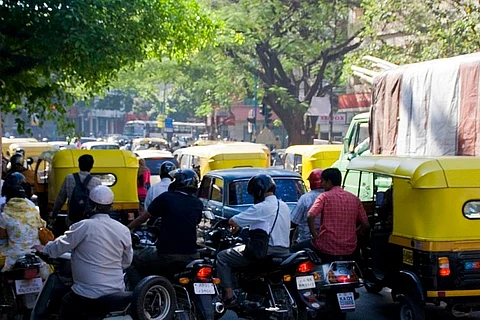

As Bengaluru’s choked roads continue to be a running joke for most commuters, the latest proposal of the BBMP has left some urban experts wondering if the corporation is building castles in the air.
According to reports, the BBMP is looking to earn Bengaluru the smart city tag through a proposal to build an aerial transport system between Whitefield and Marathahalli, among other things. Running from Marathahalli to Hope Farm Junction in Whitefield, the nearly-9km “Metrino” line, a driverless personal rapid transport (PRT) system much like a cable car, is proposed to be built at an estimated cost of Rs 1,700 crore.
Advisor and Consultant for Traffic and Transportation, MN Sreehari, who claims credit for recommending this project some years ago, says that such a system is ideal for a highly congested city like Bengaluru. “It will run on supporting columns of a very small size, like an electric pole on which the cables are strung. And whenever a station comes, the vehicle comes down to the ground, loads and unloads passengers and then goes back up to slide along the cable,” he describes.
Adding that each vehicle can seat 5-8 passengers comfortably, he says that the system is best for Bengaluru’s roads since “it will never occupy any road space”.
While the proposed idea has the sheen of a modern, new transport system, not everyone is convinced by it. Ashish Verma, Assistant Professor at the Dept of Civil Engineering in IISC Bangalore and the President of the Transportation Research Group of India, for instance, argues that with a project like the Metrino, the amount of investment versus the capacity of the system (the number of people who can be carried through a particular point in a certain amount of time) is completely asymmetrical.
“If you consider that and factor it with respect to the amount of investment that you will make to create this system, it is peanuts,” he argues, adding that this argument applies to other low-capacity, high-investment systems like monorails as well.
While Sreehari counters this objection with the argument that the Metrino won’t face congestion issues and hence more frequent schedules can be created to increase its capacity, sceptics say that there is a limit to even this solution.
Other urban commute experts extend the argument about investment versus capacity even to the Metro Rail system, arguing that even that project ignores on-ground realities. Vinay Sreenivasa, a member of Bengaluru Bus Prayanikara Vedike, a commuter rights organisation, argues that even after the second phase of the Bengaluru Metro is completed, it would cover only about 18%-20% of the population.
For a fraction of the cost that goes into that project, and for much the same cost of the Metrino, he argues, the BMTC’s fleet could easily be doubled in size.
The two reasons people don’t take buses in the city today, he says, are because of a lack of an efficient and time-bound network, and the high cost of bus fares in the city. “If you spend the money that you are spending on the metro – or plan to spend on Metrino – on the BMTC, you can give subsidised bus fares, increase the number of buses and improve the bus network as a whole,” he says.
However, Sreehari says, the problem of the BMTC fleet is not one of lack of funds but of road space. “Bengaluru’s roads are very narrow. Even on wider roads, parking is provided on both sides. The width of the roads is effectively reduced and we have 66 lakh vehicles on the road today.”
Vinay argues that such thinking is flawed because it reduces all transport questions to simply the issue of congestion. “Of course we have to look at congestion, but congestion has to be reduced for everybody. Secondly, we have to re-look at whose needs does transport serve,” he says, pointing out that public transportation today is often looked at from the prism of individual aspirations of particular classes only.
Vinay suggests that the government is formulating policy based on the middle class’ aspiration to travel on fancy air-conditioned trains and now fancy driverless pods.
Ashish, however, says that such an integrated view of transportation cannot take a metro versus buses view. Once a city has reached the kind of population density levels like Bengaluru, he argues, it is inevitable that a system like the metro would be necessary to service high-density corridors in the city. As for arguments about the inefficiency of bus services currently, he counters that such problems can’t be solved by simply increasing the number of buses in the city, as that would just result in bunching or buses coming to stops in groups with some being full and others empty.
What BMTC most needs, he argues is a scientific rationalisation of its routes and services. “The whole network of BMTC has grown in a very natural fashion with thumb rules and based on ground reports of drivers and conductors, or sometimes on feedback from passengers.”
He feels that investment in the bus network might be more productively spent on modernising the fleet. “The normal, ordinary buses that is not the quality of buses that you should provide to any section of society. They should rather focus more on modernizing their fleet with better comfort even for the lowest section of the society.”
He adds, however, that for the metro to fully play its part, it has to reach a certain threshold where most of the city is covered, and work in concert with the BMTC so that each augments the other.